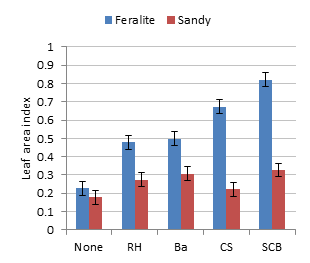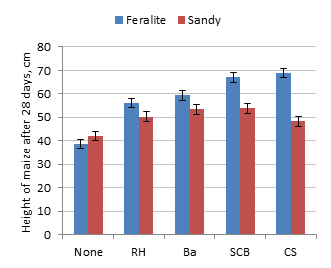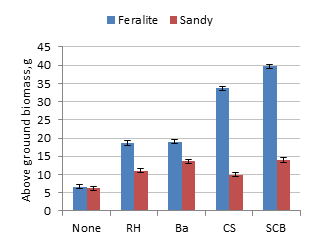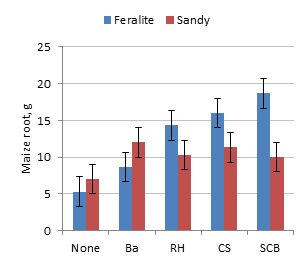



|
Livestock-Based Farming Systems, Renewable Resources and the Environment |
This study was carried out on sandy soil (Quang Binh) and feralite soil (Hoa Binh) to determine interaction between compost fertilizer and Biochar on agricultural potential of these soils and to suggest the best method to improve deprived soils in mountainous and coastal regions in Vietnam. Biochars from different materials (Bamboo, coconut hulls, sugarcane bagasse, rice husks) were used to measure effects on growth of maize on sandy soil and feralit soil. Growth of on these soils was greatest with biochar from sugarcane bagasse. Yield of maize was increased with the highest level of compost fertilizer combined with sugar cane biochar at level 40 g/kg soil.
Sandy soil and feralite soil have low potential for agricultural production. Because they have poor soil structure, a low inherent supplying capacity, low organic matter content, low pH and limited holding capacity of water, fertilizer; limit microbial activity, low fertilizer use efficiency. Thus, Nutritional management in agriculture, especially nitrogen is crucial because nitrogen easily losses through many ways such as leaching, leading to groundwater; gaseous emission, contributing greenhouse effect; erosion (Vitousek and Matson, 1985).
Biochar is the carbon-rich product obtained when biomass wood, manure or leaves…, is heated in a closed container with little or no available air, because biochar may be a substance mostly suited to severely weathered and deprived soils (low pH, absent potassium, low or no humus). It can prevent the leaching of nutrients out of the soil, partly because it absorbs and immobilizes certain amounts of nutrients; increase the available nutrients for plant growth, increase water retention. Additionally, it has been shown to decrease N2O (Nitrous oxide) and CH4 (Methane) emissions from soil, thus further reducing GHG emissions.
To determine the effects of biochar produced from different agricultural residues on growth of maize in two contrasting soils of low fertility.
The study was
carried out in Hanoi University of Agriculture, Vietnam from January to December 2011.
The experimental layout was a split-plot layout of a 2*4 arrangement with four replicates. The factors were:
Main plots: sandy soil, feralit soil
Split plots: source of biochar (bamboo, coconut shells, sugarcane bagasse, rice husks).
Sandy soil was taken from the costal province of Quang Binh province. Feralit soil was taken from the mountainous province of Hoa Binh.
The bagasse was the residue after extraction of the juice from sugar cane stalks using the simple two-roll mill traditionally used to extract sugar cane juice for drinking. It was chopped into pieces of 1-2 cm and sun-dried before being put in the gasifier stove. The bamboo stems and coconut shells were also chopped into pieces of 1-2 cm prior to sun-drying. The different feedstock were used as fuel in a down-draft gasifier stove according to the procedure described by Olivier (2010).
Mixtures were made of 80 g of biochar, 2 kg of soil, 0.4 g urea, 0.2 g potassium chloride and 0.4 g super phosphate, and put in plastic bags that had many holes in the lower part so any excess water could drain out. Two seeds of maize were planted in each bag. Water was applied uniformly to all bags every morning, except on rainy days. When the seeds had germinated, one plant was removed to leave only one seedling in each bag.
Measurements
The height of the maize plant and the leaf area index were measured every seven days. After 35 days, the plants complete with roots were removed from the bags, washed free of soil, and the green parts (leaves and stems) and the roots weighed.
The data were analyzed with the General Linear Model option in the ANOVA program of the Minitab (2000) software. Sources of variation were: Soil type, source of biomass, interaction soil*biomass and error.
|
Table 1. Mean values for effect of source of biochar. and soil type, on leaf area index, height, and fresh weights of leaf + stem and root of maize after 35 days of growth |
||||
|
Leaf area index |
Height, |
Leaf + stem, |
Root, |
|
| Source of biochar | ||||
|
None |
0.203c |
40.4c |
6.47d |
6.17b |
|
RH |
0.377b |
53.3b |
14.8c |
12.3ab |
|
Ba |
0.402b |
56.4ab |
16.3c |
10.3a |
|
CS |
0.447b |
58.6ab |
21.8b |
13.7a |
|
SCB |
0.574a |
60.5a |
26.8a |
14.3a |
|
SEM |
0.027 |
1.43 |
0.41 |
1.42 |
|
Prob. |
<0.001 |
<0.001 |
<0.001 |
<0.001 |
| Soil type | ||||
|
Feralite |
0.540 |
58.0 |
23.5 |
12.6 |
|
Sandy |
0.262 |
49.6 |
11.0 |
10.1 |
|
SEM |
0.017 |
0.91 |
0.26 |
0.90 |
|
Prob. |
<0.001 |
<0.001 |
<0.001 |
<0.001 |
| abcd Mean values withoiut common letter differe aat P<0.05 | ||||
 |
 |
| Figure 1. Effect of soil type and source of biochara on leaf area index of maize after 35 days growth | Figure 2. Effect of soil type and source of biochara on height of maize after 35 days growth |
 |
 |
| Figure 3. Effect of soil type and source of biochar on above ground biomass (leaf + stem) of maize after 35 days growth | Figure 4. Effect of soil type and source of biochar on root biomass of maize after 35 days growth |